How To Repair Cement Board Siding
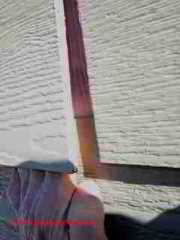 Cobweb Cement Siding Repair Advice & Specifications
Cobweb Cement Siding Repair Advice & Specifications
How to repair fiber cement lap siding butt articulation & trim articulation gaps, impairment, peeling paint, loose boards
- POST a QUESTION or Annotate near the cause & cure of butt articulation gaps in cobweb-cement siding & nigh fiber cement siding installation
InspectAPedia tolerates no conflicts of interest. Nosotros accept no human relationship with advertisers, products, or services discussed at this website.
Fiber cement lath lap siding repair guide.
This article describes repair procedures for cosmetic or functional siding issues that may arise such as loose siding, wind-damaged siding, siding pigment or coating failures, and siding gaps, especially gaps at fiber cement siding butt joints where lap siding is installed.
Our page top photo shows loose and improperly installed cobweb cement siding on a New York home. We quote from the siding manufacturer'south installation guides, contractor guides, and advisable codes & standards and we debate the pros and cons of caulking vs. flashing for sure siding repairs. We include sources for building siding back flashing & H-flashing products.
We also provide an Commodity Index for this topic, or yous can try the page superlative or bottom SEARCH BOX as a quick way to find information you lot need.
Manufacturers' Advice for Repairing, Maintaining & Protecting Cobweb Cement Siding
 Here we tackle steps to terminate ongoing leaks, impairment, or to un-do damage from either a sloppy siding installation job or from more normal wear and tear as a building's exterior siding is exposed to weather, boot balls, peeing dogs, squirrels and raccoons, or to my grandsons and granddaughters, all six of whom (Chase, Tanner, Quinn, Sophie, Zoe, Chloe) could be hired as a domicile habiliment and tear test gang.
Here we tackle steps to terminate ongoing leaks, impairment, or to un-do damage from either a sloppy siding installation job or from more normal wear and tear as a building's exterior siding is exposed to weather, boot balls, peeing dogs, squirrels and raccoons, or to my grandsons and granddaughters, all six of whom (Chase, Tanner, Quinn, Sophie, Zoe, Chloe) could be hired as a domicile habiliment and tear test gang.
Article Contents
- SIDING, Fiber CEMENT REPAIRS
- LOOSE FIBER CEMENT SIDING BOARD REPAIRS
- Cobweb CEMENT Board Coating FAIURE REPAIRS
- Cobweb CEMENT SIDING GAP CURES at Butt JOINTS or at TRIM
- RE-CAULKING vs. H-COVERS for Butt JOINT GAPS in FC SIDING - separate article
- REMOVE Private FIBER CEMENT SHINGLES or BOARDS
Our shut-up photo of a butt joint gap in this fiber cement lap siding (above left) shows the width of the shrinkage gap.
The installers failed to install the recommended backer flashing / weatherproofing at whatsoever of the butt joints that we examined and we think the siding was installed wet and possibly not properly end-butted.
Cures for Loose Fiber Cement Siding Boards
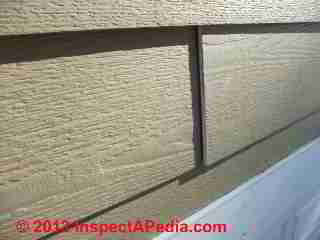
Here equally well as at page tiptop are photos of loose cobweb cement siding.
Considering that in our photo at left the siding should accept been lapped (by the board to a higher place, typically ane one/four"), for this cease butt joint to exist completely out of alignment with its neighbor we figure that the board above was also not properly nailed, possibly bulged as well.
Too notice that the boards are misaligned vertically also. All of these clues advise a super high-speed, sloppy siding installation by un-trained and un-supervised installers.
For more than diagnosis we ask about the fiber cement siding'due south original installation & nailing: was the siding installed according to the product specifications for type of boom, smash spacing, overlap, dorsum priming, butt joint and trim joint end priming & caulking? Run across the product's caulking, nailing, flashing, installation details provided by James Hardie and excerpted in our notes beneath.
Except in high air current areas, the production is installed using blind nailing (nails at the tiptop of each siding course are covered past the succeeding course). Nails (or screws for metal stud applications) must exist corrosion resistant, galvanized or stainless steel. Hot-dipped galvanized fasteners or stainless steel (near salt or ocean areas) are recommended.
Pin-Dorsum Nailing repairs for loose fiber cement siding
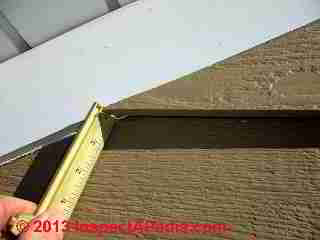
In James Hardie's technical bulletin No. 17, the visitor provides a clarification of PinBack nailing for use at loose planks that were "high nailed" at original installation) or where there are problems with gaps, loose planks, or rattling noises.
At left we show a different loose siding problem: where the diagonal end-cut siding was installed against the domicile's sloping gable-terminate trim, the installer perchance couldn't grab a stud, or perhaps due south/he simply didn't want to move the ladder to blast the finish of the siding board.
Now just a few years afterward the siding ends are curled away from the building. How can nosotros prepare this other than by a complete removal and replacement of this wall covering?
Excerpting:
- Pin Backs Pinning the plank down at the bottom edge is a mutual do called "pin back." Information technology is used to correct "loftier nailing", loose planks, gaps or rattling. Pinning of the butt joints with is non intended to increase wind load values; and shall exist installed 3/8" from cease and between iii/four" and 1" from bottom edge.
The terminate nail shall be nailed affluent to the surface (not countersunk), must be corrosion resistant (e.g. galvanized or stainless) and does not provide structural support. For best aesthetics blast heads should be touched up to color match. [17]
Cures for Buckled Fiber Cement Lap Siding
Buckled fiber cement siding is nearly probable to occur considering the installer failed to give the recommended gap betwixt the ends of the fiber cement boards and abutting vertical trim at corners, windows, doors, etc.
Buckling cobweb cement siding may besides occur if the product was not properly nailed.
It may be possible to cutting an cease gap clearance in place between the siding terminate and vertical trim, wearing proper protective gear to avoid silica dust hazards etc.
Also see Pin Back Nailing discussed above.
Cures for Coating Failures on Fiber Cement Siding
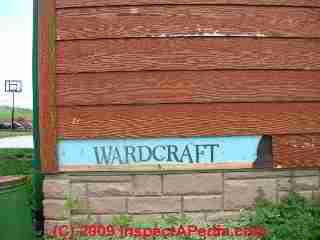
At JAMES HARDIEPLANK® FC SIDING we discuss the failure of this factory-coated cobweb cement siding installation.
- Coating type originally used: what type of paint was used on the product? Was information technology back-primed (if recommended) or factory primed? What is the wet resistance of the coating used?
The siding should be painted (apply an acrylic paint) inside 180 days for primed products or within ninety days for unprimed products. Practice not use stain; exercise not use oil/alkyd-based paints;
Practice not use stain on James Hardie products.
The visitor also warns against painting when the surfaces are moisture - a topic that we elaborate ad nauseam
at PAINTING MISTAKES.
The James Hardie visitor provides special impact-up coatings for ColorPlus products.
- Painting fiber cement siding: Take care when re-painting, to avoid incompatible paints. The company recommends 100% acrylic paint. [14] See James Hardie Technical Message 17 for painting and other fiber cement repair recommendations.
- Sealing / caulking cobweb cement siding: how were butt joints and end joints treated, flashed, caulked? Cut ends of cobweb cement siding should accept been sealed using 100% acrylic latex primer or paint (Certainteed) or in some cases using an approved caulk wiped on the cut surface (see our notes on Hardieplank installation). And caulk is required at certain joints such every bit vertical trim at windows, doors, corners.
Caulk is not to exist installed in J channel, F-channel, nor in cobweb cement siding butt joints, though information technology may accept been applied later by a homeowner or maintenance contractor.
Check the caulking specifications provided in the installation guide by the manufacturer for your specific siding product. For example OEM specifications on caulking for fiber cement siding, see SIDING, FIBER CEMENT GAP & CAULK SPECS.
Frankly, my OPINION is there is no overnice cure for cobweb cement siding with a coating failure such as shown in our photograph. As we discuss in excruciating detail in our article serial beginning at PAINT & STAIN GUIDE, EXTERIOR, surface preparation is the cardinal to a durable paint job.
Fifty-fifty the most sophisticated blanket will fail if sprayed over dirt, for example. See Paint SURFACE PREPARATION for more help.
How to Decide on a Remedy for Pigment Failure on Siding
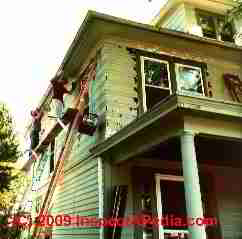
Choosing the all-time remedy for failing paint on cobweb cement siding or any other exterior building surface depend on at least these considerations:
- What is the base of operations product material, and what condition is information technology in. For example failed paint on hardboard siding, if the siding has delaminated, means it's time to replace the siding.
See details at SIDING HARDBOARD
Watch out: some siding materials and surfaces but cannot exist finer and economically "saved" by re-painting. Siding replacement may be a less plush option in a number of circumstances.
- How do we remove peeling paint from a factory-painted fiber cement product, how much bad paint exercise we remove, how aggressive should nosotros exist?
See MEDIA Blasting for MOLD REMOVAL - a technique that can set a bad surface for painting.
- How do we fix the cleaned surface for re-painting? Is there chalking of remaining paint? Do we need to use a special primer?
see Pigment SURFACE PREPARATION
- What paint or coating should be used? Talk with both the siding manufacturer as well as your pigment supplier. For fiber cement siding the paint and primer need to exist compatible with fiber cement products.
- How should the coating be practical? Spray is fast and less costly simply may non bond the paint as well to the surface. With Fine art Cady I had success working as a team, using spray to get the pigment onto the surface and a roller to work information technology into the surface for better adhesion.
Cures for Open up Butt Joint Gaps in Cobweb Cement Lap Siding Installations
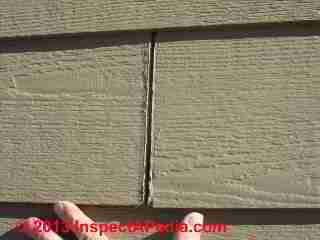
Corrective issues: Edifice owners should as well be made aware of possible hereafter corrective issues, depending on the repair method used and workmanship;
For cosmetic concerns, if building condition permits a slower arroyo, consider trying more one product and method for gap sealing, examining the immovability and appearance of the repair after 12 months or longer of atmospheric condition exposure on the about-challenged building sides.
Details most repair approaches to open up barrel joints in fiber cement lap siding are give at SIDING, FIBER CEMENT GAP CURES.
There we also hash out adding back flashing to seal open up lap siding barrel joints against leaks into the wall arrangement.
Cures for Algae, Mucus, Moss, Lichens on Building Siding
Algae, fungus, moss or lichens on siding are ordinarily due to a combination of wet and shade on the building wall. Plants too close to the edifice wall, repeated wetting by sprinkler systems, or unnecessarily dense close shade tree growth are weather condition that tin can usually exist remedied.
See TREES & SHRUBS, TRIM OFF BUILDING.
For more most algae, lichens, moss growth on buildings
see ALGAE, Mucus, LICHENS, MOSS.
Adjusted, expanded & excerpted from CertainTeed Corporation'due south "CertainTeed WeatherBoards™ Fiber Cement Siding Installation Manual" [5a], from "Cobweb Cement Siding Best Practices for Constructive Task Site Management"[5b] and from JamesHardie Corporation installation instructions and bulletins for JamesHardie HardiePlank lap siding. [12][12b] and finally besides from applicable edifice codes & standards.
How to Remove Individual Fiber Cement Shingles or Boards
Reader Question: how exercise I remove individual or bottom fiber cement siding boards?
twenty January 2022 Tony said:
I need to remove a bottom Hardie Lap siding board because information technology has deteriated from the furnace condensation outlet. I have replacement boards but how do I remove the lesser board by itself when there is a board above information technology and covering the nails, etc.
Reply:
Great Question, Tony. I have had to deal with this problem on FC shingle siding, lap siding and also on slate roofs.
If the FC siding has been painted such that the lower edge of the upper board is sealed tightly to the 1 below, cut the paint seal with a utility pocketknife.
Then utilize 1 of the following methods to cut the nails holding the lower board:
If the lower edge of the upper board above the i to exist removed is face-nailed through the lower edge of the upper board, reaching between the two boards, cut the nails with a hacksaw bract or slating tool as I describe adjacent:
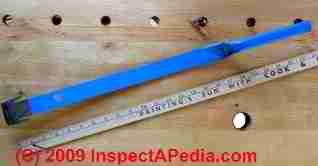 For slate roofs there is a hammer-tool that can exist used for some siding removal - the tool slips up under the upper slate, a sharp flat hook slides over the nail, an outside handle of the tool is hammered down to cut the nail - just yous may have problem finding this tool.
For slate roofs there is a hammer-tool that can exist used for some siding removal - the tool slips up under the upper slate, a sharp flat hook slides over the nail, an outside handle of the tool is hammered down to cut the nail - just yous may have problem finding this tool.
Only you lot can see it - the brilliant blue tool illustrated nigh the top of the commodity -
at SLATE ROOF SOURCES & TOOLS and shown here.,
Alternatively, working carefully then as non to break the Hardie Lap boards above the ones to be removed, you can use a hacksaw bract to slip up between the boards, slide it horizontally to find the next nail, so saw through the boom. Buy a few metal-cutting hacksaw blades and a unproblematic handle that attaches to one terminate of the blade leaving about 6" of free hacksaw blade.
If the FC lap siding boards are nailed very tightly you may be able to achieve up under the board you are going to remove, using a flat bar, to pry GENTLY at the peak of the lath, below thus the board to exist removed and the lower border of the board course above it, prying thus between the dorsum of the lower board and the wall sheathing, just enough to open the boards plenty to go back to the hacksaw. Don't pry too much or you'fifty pause the lath above.
If the lower board was blind-nailed, that is nailed to the wall through its upper edge such that the second class lapped over the nails belongings the start form board in place, you'll demand to ....
Gently pry up the lower lath using a apartment bar beneath its lower border just enough to be able to slide the flat bar up to the upper border of the lath to find where it is nailed.
From that position y'all probably tin can't employ the hacksaw fob I describe above, merely you lot can use either the slating tool I describe to cut the nails OR you can use a thin flat bar to drive up, cutting each nail in position.
Take intendance not to pry too much or you'll pause the boards above.
More than details about removing fragile or brittle siding materials are
at ASBESTOS CEMENT SHINGLE REMOVAL
How to Repair Minor Chips, Dings, Damage in Fiber Cement Siding like HardieBoard
Question: how to repair bubbles & holes on the HardieBoard Siding on my home
2017/04/04 Norris said:
I have a hardy board at each corner of our front porch. Looks like a 1x6 by 8 long. Both pieces have numerous bubbles opening up and showing open holes on the face and the sides. Business firm is ten yrs old. What would be the best patch / repair treatment? Cheers
Respond:
Norris:
Discussing their HardieZone HZ10 siding Hardie says:
Repair or Patching Fiber Cement Board Siding
Dents, chips, cracks and other minor surface damage in James Hardie siding and trim products can be filled with cementitious patching compound. Refer to manufacturer recommendations for products that are uniform with cobweb cement.
For small areas of impairment y'all can use a sealant/caulk (preferably i designed for cement repairs) merely then you will have to paint those areas of repair to match the original color.
Opinion: Clean out the area of impairment, removing loose material but trying non to gouge into the boards. For larger areas I adopt to use a cement (or "cementious") patching compound, sold in plastic tubs or in tubes that can be used in a caulking gun. If your boards include a pattern such equally a wood grain, small-scale areas of repair can be tooled to match the surrounding lines with a putty knife; for larger areas of repair some owners have tried making a clay impression of nearby surfaces to printing into the patch.
Hardie sells touch-upwards paint that tin can match the color of your HardyBoard siding.
Boards that are actually broken away volition demand to be cutting out and replaced.
Here is what James Hardie says about repairs to their siding production:
James Hardie [JH] does not corroborate employ of JH canonical color matched caulk, other caulking materials or cementitious patching compounds to bear upon up blast heads, blast holes, dents, chips, cracks or other small-scale surface blemishes on JH products with ColorPlus® Technology.
Warranty Coverage
James Hardie routinely receives inquiries from consumers and builders regarding the use of pigment as touch-up on ColorPlus products. These inquiries sometimes include requests that James Hardie provide warranty coverage to remediate problems associated with paints, and other non-approved materials as impact-ups.
James Hardie'south warranty provides coverage for defects in materials and workmanship on ColorPlus products and its Touchup only. It does not warrant, in whatsoever respect, the appearance or functioning of any tertiary party coatings or finishes, including paint, used every bit bear on-up and tertiary party touch-up paints used on ColorPlus products. - Touch-Upward Detect to Contractors and Consumers
- Best Practices – Installation Guide, Siding and Trim Products [PDF] (Version eight.3 - May 2022) for HardiePlank®, HardieShingle®, HardiePanel®, HardieTrim®, HardieSoffit®, retrieved 2022/04/04, origial source: https://www.jameshardie.com/d2w/best-practices/intro-tools-hz10-us-en.pdf
See "Repair Patching" p. 27
Excerpt:Paring, chips, cracks and other minor surface harm in James Hardie primed siding and trim products can be filled with cementitious patching compound except on ColorPlus. When repairing holes of less than ane in. that has been created past scaffold anchors, pipe, etc. James Hardie recommends a backer rod be placed rod be placed into hole and sealed to prevent h2o infiltration. James Hardie will assume no responsibility for water infiltration.
- HardieBacker® Cement Board Warranty[PDF] (2010) JamesHardie, 26300 La Alameda, Suite 400, Mission Viejo, CA 92691, Tel: 1-866-442-7343, Website: www.jameshardie.com (2010) retrieved 2022/04/04, origial source: https://world wide web.jameshardie.com/pdf/warranty-backer.pdf
- HZ5® Intendance and Maintenance Guide [PDF], (2010) JamesHardie, op.cit.,
- HZ10® Intendance & MAINTENANCE GUIDE [PDF], JamesHardie, op.cit., (2010) retrieved 2022/04/04, origial source: https://world wide web.jameshardie.com/pdf/HardieZone-HZ10-Intendance-and-Maintenance-Guide.pdf
- Bear on-Upward Detect to Contractors and Consumers [PDF], retrieved 2022/04/04, original source: www.jameshardie.com/JamesHardieMainSite/media/Site-Documents/TechnicalDocuments/color-plus-touch-up-paint-notice-english.pdf
- FEMA Recognition of Hardfie-Board [PDF], James Hardie's non-asbestos fiber cement interior lining & exterior siding products equally Class V Materials [PDF], retrieved 2022/04/04, original source: https://www.jameshardie.com/pdf/fema.pdf
Reader Q&A - also see the FAQs series linked-to below
You lot can supersede the damaged sections (work with care); You could also back-flash and so but paint the cracked siding;
any sealant or "patch" will "piece of work" mechanically to seal the crack but information technology'll exist ugly when painted.
Hullo. My mobile is xx yrs old and has the cement fiber siding. We want to paint but accept noticed some cracks in the cement. Whats the all-time way for a home owner to repair this before we paint. Thanks
Ps
But don't let your favor bamboozle you. If the painter is referring to the uncomplicated business firm wrap that's not a skillful solution. Yet if at that place was really individual flashing at each barrel joint that would be practiced practice.
Kass
Ameliorate and more right would exist back fkashing at each siding butt joint. Caulking is n ok t always recomnended and in fact can cause a corrective problem on textured surfaces.
My home inspector called out that the newly painted difficult lath siding didn't accept new caulking in the butt joints. The home was built in 2001. The painter said the butt joints don't need to be caulked and that the backing paper was adequate to forbid moisture intrusion. Many of the siding boards accept nails at the bottom of the butt joints, and then later on-installation flashing isn't a proficient selection. Should I have what the painter says? He is experienced. I am in the Pacific Northwest.
I got a quote for hardy siding and I was curious virtually all this myself. This commodity does have a lot of good things to say. Is there a good company to become with when it comes to this I got a quote from conservation construction of texas and lowes. Does anybody else have suggestions?
I have chipped/dented the face up trim around my garage door while turning into the garage with my truck. Take been searching for DIY advice on how to remove the damaged exterior trim slice (this is non a jamb, only rather the "picture frame" effectually the door) and supplant it. Would call someone, but finding reliable and reputable workmanship in my surface area is a love shoot at best. Whatever aid would exist appreciated. Contact gkorous@gmail.com
Thank you Greg for the encouragement; nosotros work hard on this stuff then I'm actually happy when a reader finds it useful. We likewise welcome content suggestions and critique.
Daniel
Cheers for such a expert article here likewise as the picts...
Mike,
E-mail for mailing photos tin can exist establish at the page elevation or lesser CONTACT link.
The house I am working on has hardy siding just the bottoms of the vertices corner pieces are rotting. I am beginning to think that those pieces are not Hardy but some type of masonite kind of material. The Hardy siding pieces are skillful. How tin I send you lot some pictures?
Mike,
I retrieve I'm missing part of the question hither, and so you lot may demand to elaborate or use the folio top or lesser CONTACT link to send me photos of the problem.
I think I'd cut any sealant/caulk with a knife and pull off the corner trimt if replacement were needed.
How do I supplant the vertical corner pieces of hardy board siding that run from the tops to the bottom of the firm?
Norris:
Discussing their HardieZone HZ10 siding Hardie says:
Repair or Patching
Dents, fries, cracks and other minor surface damage in James Hardie siding and trim products tin can be filled with cementitious patching compound. Refer to manufacturer recommendations for products that are compatible with fiber cement.
For small-scale areas of harm yous can use a sealant/caulk (preferably one designed for cement repairs) only then you volition have to paint those areas of repair to friction match the original colour.
OPINION: Clean out the surface area of damage, removing loose cloth but trying not to gouge into the boards. For larger areas I prefer to apply a cement patching chemical compound, sold in plastic tubs or in tubes that tin be used in a caulking gun. If your boards include a pattern such as a wood grain, pocket-size areas of repair tin can be tooled to match the surrounding lines with a putty knife; for larger areas of repair some owners take tried making a dirt impression of nearby surfaces to printing into the patch.
Hardie sells touch-upwardly paint that tin friction match the colour of your HardyBoard siding.
Boards that are actually broken away will demand to be cut out and replaced.
Here is what James Hardie says about repairs to their siding product:
James Hardie [JH] does not corroborate use of JH approved color matched caulk, other caulking materials or cementitious
patching compounds to touch upwardly boom heads, nail holes, dents, chips, cracks or other minor surface blemishes on JH
products with ColorPlus® Applied science.
Warranty Coverage
ames Hardie routinely receives inquiries from consumers and builders regarding the utilize of paint as impact-up on ColorPlus
products. These inquiries sometimes include requests that James Hardie provide warranty coverage to remediate bug
associated with paints, and other non-canonical materials as touch-ups.
James Hardie's warranty provides coverage for defects in materials and workmanship on ColorPlus products and its Touchup
only. It does not warrant, in whatsoever respect, the advent or performance of whatsoever third party coatings or finishes, including
paint, used every bit touch on-up and third party touch-up paints used on ColorPlus products
- Touch-Up Discover to Contractors and Consumers, retrieved 2022/04/04, original source: world wide web.jameshardie.com/JamesHardieMainSite/media/Site-Documents/TechnicalDocuments/color-plus-touch-up-pigment-observe-english.pdf
I have a hardy board at each corner of our front porch. Looks like a 1x6 by 8 long. Both pieces have numerous bubbles opening up and showing open holes on the face and the sides. House is 10 yrs old. What would be the all-time patch / repair treatment? Cheers
...
Continue reading at SIDING, Fiber CEMENT MAINTENANCE or select a topic from the closely-related articles beneath, or run into the complete ARTICLE INDEX.
Or meet SIDING, FIBER CEMENT REPAIR FAQs - questions & answers posted originally at this commodity.
Or see
SIDING, FIBER CEMENT - dwelling
Suggested citation for this web page
SIDING, FIBER CEMENT REPAIRS at AuditApedia.com - online encyclopedia of building & environmental inspection, testing, diagnosis, repair, & problem prevention advice.
Or encounter this
INDEX to RELATED ARTICLES: Commodity Index to Building SIDING
Or apply the SEARCH BOX plant beneath to Ask a Question or Search InspectApedia
...
Ask a Question or Search InspectApedia
Try the search box just below, or if you prefer, postal service a question or comment in the Comments box below and we volition respond promptly.
Search the InspectApedia website
Notation: appearance of your Comment below may be delayed: if your comment contains an paradigm, web link, or text that looks to the software as if information technology might exist a web link, your posting volition appear after it has been approved past a moderator. Apologies for the delay.
Technical Reviewers & References
Click to Prove or Hide Citations & References
Publisher InspectApedia.com - Daniel Friedman
How To Repair Cement Board Siding,
Source: https://inspectapedia.com/exterior/Siding_Fiber_Cement_Repair.php
Posted by: wardnearst.blogspot.com


0 Response to "How To Repair Cement Board Siding"
Post a Comment